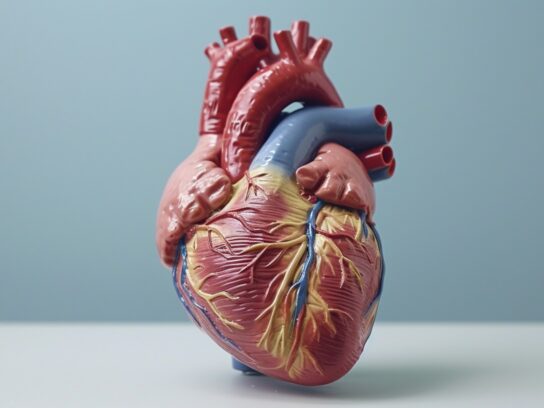
This month, doctors and other medical professionals are trying to raise awareness about heart disease. Former President Lyndon Johnson designated February as American Heart Month in 1964.
Many people wonder how they can keep their hearts healthy, especially as they age. Doctors say while genetics does play a role, lifestyle choices also are a factor. Medical experts say smoking, a sedentary lifestyle, and a poor diet are often major contributors to heart problems.
Treatments for Heart Disease
While heart disease remains the number one killer of Americans, medical breakthroughs have kept millions of people alive who otherwise would have died without current treatments.
Dr. Ameya Kulkarni is the associate medical director for Kaiser Permanente. He also serves as Board President for the American Heart Association in the Greater Washington Region.
He said there has been massive progress in treatments in recent decades.
“Before 1961, the 30-day mortality rate from people suffering a heart attack was more than 20%. Now the 30-day mortality rate is around 2%. When the U.S. Surgeon General put a warning label on cigarettes, we started seeing reductions in smoking rates. That was a big contributor. Second, our medical therapy is incredible. The tools we have to protect your heart once a person has had a heart attack are wonderful. The technology is at a point now where if somebody has a heart attack and the individual comes into my cath lab, I can fix the patient’s heart artery with a small incision in the wrist and the patient can go home the same day,” Kulkarni said.
Obesity and Heart Risk
He said despite all of the progress, there is still a lot of work to do. He said there are some new threats to keeping people’s hearts healthy. People are more sedentary than they were 50 years ago and the obesity rate is up.
The Centers for Disease Control and Prevention (CDC) estimates 39.2% of men are obese while the rate for women is 41.3%.
In recent years, doctors have tried a new approach to treat patients who are overweight with drugs known as GLP-1 receptor agonists. The most popular names of those drugs are Ozempic, Wegovy, and Mounjaro to name a few.
MCM spoke with Dr. Daisy Lazarous who directs the Women’s Cardiovascular Program at Adventist Healthcare. Lazarous said these new weight loss drugs show a lot of promise and researchers are still studying them. However, it appears women tend to benefit more from these drugs, but they also experience more side effects such as nausea.
Men vs. Women
Lazarous said, in general, men and women experience cardiovascular disease differently from each other.
“Coronary artery disease is a buildup of cholesterol inside the arteries. Men tend to build up cholesterol in the large arteries that run on the surface of the heart. While women tend to build up cholesterol in the small arteries, so women tend to have more microvascular disease. When a doctor does an angiogram, which is putting dye inside the arteries, he or she may look at a woman’s heart and determine the patient is fine because the scan does not show any blockage. But that is a wrong approach because women tend to have cholesterol buildup in the small vessels of the heart. That can lead to spasms and angina,” Lazarous said.
Different Symptoms
When men and women are having a heart attack, they also will present different symptoms.
“About 65% of men and 55% of women who have a heart attack will have what we call crushing chest pressure. Patients often describe it not as pain, but rather pressure, like an elephant was sitting on the left side of their chest. That is the most classic symptom. Often patients will feel that discomfort going up through their shoulder and around their left arm. They also may feel tingling in their fingertips. Sometimes they will feel hot or sweaty. Patients can feel short of breath and uncomfortable,” Kulkarni said.
“Women can present with atypical symptoms. While they can have chest pain, they also can have shortness of breath, a little dizziness, sweating, pain in other areas of the body, like the jaw or the stomach. Oftentimes, when women present with these symptoms, doctors do not always assume, their female patients are having a heart attack. This is why women are often underdiagnosed and undertreated when heart attacks happen,” Lazarous said.
When women are younger, they have an advantage over men because they have more estrogen in their bodies.
“Estrogen is very cardio protective,” Lazarous explained.
“However as women grow older and towards menopause, they lose that benefit. Older women without the same amount of estrogen tend to have a similar risk to men in terms of having a heart attack,” Lazarous added.
More Information
On February 26, Adventist Healthcare will hold a webinar to provide more information on women’s cardiovascular health. Lazarous will help lead the discussion along with Patricia Hertz, a dietitian who works with cardiac rehabilitation patients.
The online event takes place between noon and 1 p.m. For more information:
https://www.adventisthealthcare.com/calendar/details/?eventId=c31fe87c-a0d9-ef11-a870-000d3a611ea2
Adventist Healthcare also is offering people a chance to take a free heart health risk assessment this month. The online tool can help people gauge their risk of heart disease.
Don’t Wait, Get Checked
Kulkarni recommends people not wait if they suspect something is wrong with their heart health.
“What I say is rather than thinking about the specific symptoms you may be experiencing, get it evaluated. Your body is pretty good at telling you something is wrong. The best way to figure out whether something is right or wrong is get it evaluated,” Kulkarni said.
He said checking in with your primary care doctor is an important first step. Usually, patients will see a cardiologist once they have symptoms.
Prevention is Key
However, there are steps people can take to prevent heart disease from developing. Lazarous said if people smoke, they should quit. She also recommends people avoid excessive drinking, and she said people should try to get 150 minutes of exercise each week. People also need to watch their diets. She said these simple lifestyle modifications can go a long way to reducing a person’s risk of having a heart attack or stroke.

Comments are closed.